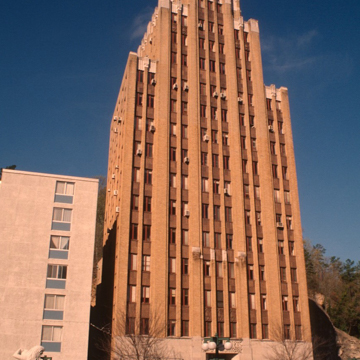When this 180-foot sixteen-story Art Deco building was erected, it ranked as the tallest structure in the state, a title it held until the Tower Building (PU19) opened in downtown Little Rock in 1960. The reinforced concrete structure’s setbacks at the twelfth, fifteenth, and penthouse floors emphasize its height, as do the prominent brick pilasters that rise uninterrupted between the windows to decorative stone cornices. The ground floor, of light-colored stone on a dark green polished granite base, has its central entrance framed by streamlined fluted pilasters and its name carved in stylized letters across the top; an ornate bronze grille is over the transom. The building was home to most of the town’s medical professionals, in part because St. Joseph’s Hospital was located a few blocks away near the intersection of Central, Park, and Whittington avenues. After both of Hot Springs’s hospitals relocated to the perimeter of the city, they were followed by the doctors. Today the building is largely vacant.
You are here
Medical Arts Building
If SAH Archipedia has been useful to you, please consider supporting it.
SAH Archipedia tells the story of the United States through its buildings, landscapes, and cities. This freely available resource empowers the public with authoritative knowledge that deepens their understanding and appreciation of the built environment. But the Society of Architectural Historians, which created SAH Archipedia with University of Virginia Press, needs your support to maintain the high-caliber research, writing, photography, cartography, editing, design, and programming that make SAH Archipedia a trusted online resource available to all who value the history of place, heritage tourism, and learning.















